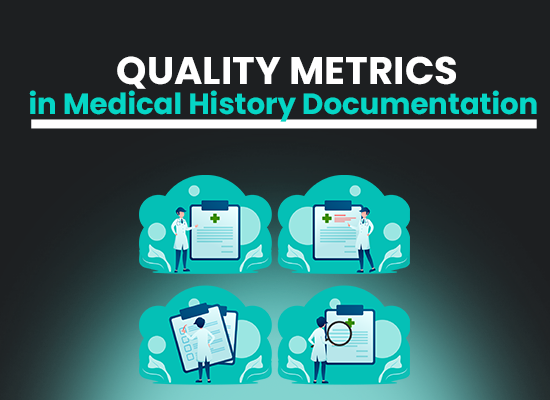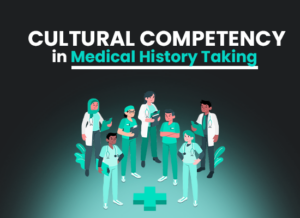Quality Metrics in Medical History Documentation
- February 21, 2025

Table of Contents
Quality documentation plays a vital role in ensuring the safety and effectiveness of patient care. By tracking key quality indicators, healthcare providers can ensure that medical histories are well-documented. This, in turn, helps make better clinical decisions and improves patient outcomes.
Essential Quality Indicators in Medical History Documentation:
For medical history documentation to be useful, it must meet several important quality standards. These quality indicators ensure the information is accurate, helpful, and ready to be used by all healthcare providers involved in a patient’s care. Meeting these standards leads to better decision-making and patient management.
- Ensure medical history is complete to provide full context.
- Always verify the accuracy of documented information.
- Timely updates ensure the most current information is used.
Don’t Miss This Exclusive AI in Healthcare Webinar!
Feb 26 | 1:00 PM ET – Discover how AI enhances medical documentation. Get a FREE trial & experience it before the event! Register Now & Claim Your Free Trial!
Completeness:
Medical histories must capture all relevant details. Missing information can lead to errors in diagnosis or treatment. A complete record helps healthcare providers assess a patient’s condition more thoroughly.
Accuracy:
It is essential that the information documented is correct. Inaccurate information can lead to prescribing wrong treatments or missing critical health issues. Double-checking facts ensures the safety of the patient.
Timeliness:
Timely documentation ensures that the most current information is available for patient care decisions. Outdated records can cause delays in treatment. Recording updates in real-time is ideal for providing quality care.
More Quality Indicators to Ensure Better Documentation:
In addition to completeness, accuracy, and timeliness, there are other key indicators that affect the quality of medical history documentation. These additional indicators help further ensure that the medical records are usable and meet the required standards for patient care.
- Keep documentation consistent to avoid confusion.
- Ensure records are legible to reduce the risk of errors.
- Ensure medical histories are easily accessible to healthcare providers.
Consistency:
Consistent documentation ensures that the patient’s history is presented clearly across different visits. This avoids confusion or contradictions in the medical record. Consistent formatting helps healthcare providers easily understand the information.
Legibility:
Whether digital or handwritten, records must be easy to read. Poor handwriting or unclear digital entries can make it difficult to interpret the data. Clear, legible records reduce the risk of mistakes.
Accessibility:
Medical histories must be readily accessible to the healthcare team. Difficult-to-find records can cause delays and hinder treatment decisions. Electronic health records (EHR) systems have made access easier, but manual records must also be stored properly.
The Role of Compliance in Medical Documentation:
Compliance with healthcare regulations and standards is a critical aspect of quality documentation. Following legal and ethical guidelines helps protect patient privacy and ensures that healthcare providers meet the necessary standards for care. By maintaining compliance, healthcare organizations can avoid potential legal and financial issues.
- Ensure all documentation complies with healthcare regulations.
- Follow legal and ethical standards to protect patient privacy.
- Compliance helps avoid potential legal issues.
Compliance:
Documenting medical histories in accordance with healthcare regulations is a must. This ensures that all information is collected, stored, and shared legally and ethically. Adhering to these standards helps protect patient rights and maintain trust in the healthcare system.
How Quality Documentation Enhances Clinical Decision-Making:
Accurate, complete, and timely documentation supports better decision-making. Healthcare providers rely on documented information to assess conditions and make treatment plans. Quality documentation reduces the risk of errors, improves care coordination, and leads to better clinical outcomes.
- High-quality records support better decision-making.
- Clear documentation ensures better coordination among healthcare teams.
- Proper documentation leads to improved patient outcomes.
Improved Decision-Making:
Having high-quality medical history records allows healthcare providers to make better-informed decisions. It helps in diagnosing conditions more accurately and selecting the right treatments. Timely and accurate records enhance decision-making at every stage of patient care.
Better Care Coordination:
Quality documentation ensures that everyone involved in a patient’s care is on the same page. Clear records allow doctors, nurses, and other healthcare professionals to work together effectively. It helps avoid duplicate tests and treatments.
Enhanced Outcomes:
When healthcare providers have access to accurate and complete medical histories, they can offer the best possible care. This leads to better patient outcomes, as the treatment can be tailored to individual needs based on a thorough understanding of their health.
Don’t Miss This Exclusive AI in Healthcare Webinar!
Feb 26 | 1:00 PM ET – Discover how AI enhances medical documentation. Get a FREE trial & experience it before the event! Register Now & Claim Your Free Trial!
Conclusion:
In conclusion, quality documentation is essential for better clinical outcomes and patient care. By focusing on key quality indicators, healthcare providers can ensure they are providing the best possible service to patients. Timely, accurate, and complete records support better decision-making, reduce errors, and enhance overall patient safety.
Read More Blogs
See what’s trending in the medical world with our blogs.




